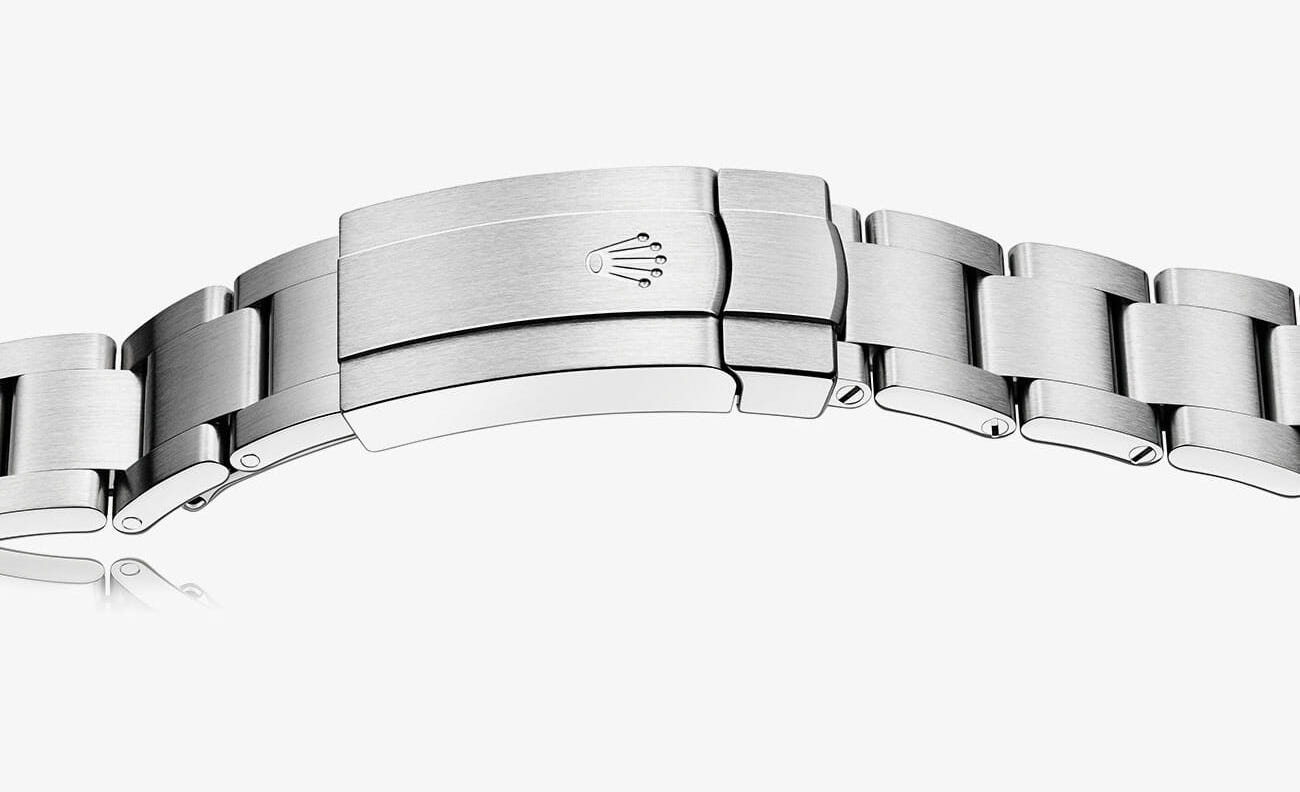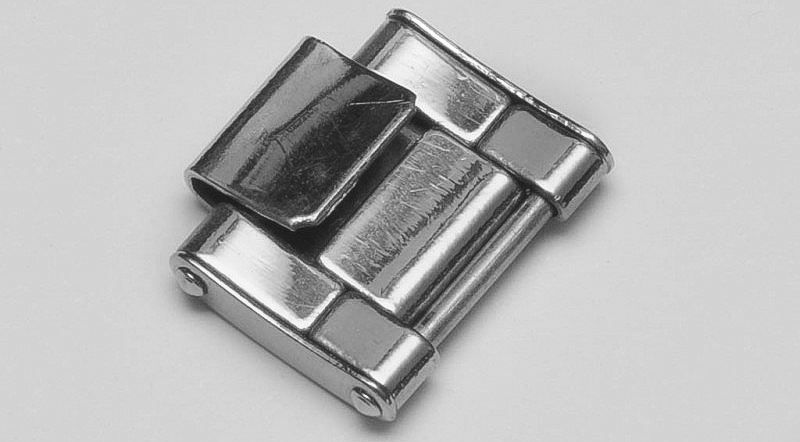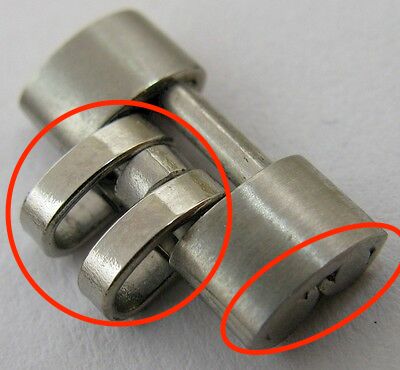
Rolex Oyster bracelet: Complete guide
The Rolex Oyster bracelet is perhaps the most iconic and distinct metal bracelet in the whole watch industry.
Today, it is the most recognizable watch bracelet design in the world, and it is evident that the Oyster bracelet has had a big influence on other manufacturers’ watch bracelet. Some may say that the Oyster bracelets is the definition of a sports watch bracelet.
But the fact is that the Rolex Oyster bracelet hasn’t always been what it is today. Robust, reliable, uncompromising, and with full rigidness.
Looking back at the history of the Oyster bracelet reveals that it has done quite a journey. At its core, it has always remained the same three-link bracelet design structure, but apart from that, most things have changed.
This is a complete guide to the Rolex bracelet. History, specifications, details, and background.
Rolex Oyster bracelet, the complete guide
The modern Oyster bracelet is robust, sturdy, and reliable. With its solid links, the bracelet does not get much stretch over time. The bracelet is manufactured in steel, full yellow gold, full rose gold, Rolesor (rose gold and steel or yellow gold and steel), and lastly, platinum.
The bracelet can either be fully brushed or, it can have polished middle links. Oyster bracelets with polished middle links are less sporty, and therefore, they are used for watches where Rolex wants to enhance the elegance of the watch.
By looking at the reference number of a watch, you can tell which metal type the watch should have. The Oyster bracelet is made of all types of precious metals that Rolex uses.
The last digit in the reference number of a Rolex watch indicates which metal is used.
For example, the 116610 Submariner has a 0 as the last digit, which means the watch (and thus also the bracelet) is made of stainless steel.
0 = Stainless Steel
1 = Yellow Gold Filled
2 = White Gold Filled or Stainless Steel & Platinum
3 = Stainless Steel & Yellow Gold
4 = Stainless Steel & White Gold
5 = Gold Shell or 18k Pink Gold or Rose Gold
6 = Platinum
7 = 14k Yellow Gold
8 = 18k Yellow Gold
9 = 18k White Gold
Rolex has, over the years, released a number of iconic bracelet designs, which are often associated with a few particular models.
The President, for example, is only used in the Day-Date today, and the Pearlmaster is only used for the Pearlmaster. The rubber strap is a more recent invention from Rolex, and leather has taken less and less space amongst Rolex’s collection as the market asks for other things.
- Oyster
- President
- Jubilee
- Pearlmaster
- Leather
- Rubber
Rolex bracelet manufacturing
It’s very evident that Rolex has made huge progress when it comes to both design and the technical functions of the Oyster bracelet.
When you look at how Rolex makes its watches, it’s clear that they do so in a way that ensures long-lasting durability. The aim is that the watches last for generations.
This is why much progress has been made with the Oyster bracelet.
History of Rolex Oyster bracelet
The Rolex Oyster bracelet was first seen in the late 1930s. Today, it is Rolex’s most popular bracelet, and it is certainly one of the most iconic.
Its design is made up of three flat link pieces, with a large piece in the center and two thinner on each side. Due to this structure, you get a more robust bracelet that will not get as much stretch as the Jubilee bracelet did at the time.
The Oyster bracelet is considered the sports bracelet for Rolex watches, and this sounds reasonable as it is used in most of the watches in the Professional collection. In fact, it is used in all professional collections. The Oyster bracelet is also used on some classic models such as the Datejust, Day-Date, and Sky-Dweller. It can be equipped with all types of Rolex clasps (Oysterclasp, Oysterlock, and Crownclasp) and can include the Easylink comfort extension link system. With that said, there are multiple clasp versions used on this bracelet.
Over the years, Rolex has continuously made slight improvements to ensure a higher quality bracelet. But to get a full understanding of the bracelet, we have to go back quite a bit in history.
Rolex Gay Frères Bracelets
Originally, Rolex didn’t manufacture its own bracelets. Like most Swiss watch companies, Rolex outsourced many parts of its production before taking it in-house. One such part of its production is the manufacturing of its bracelets.
The company Gay Frères actually manufactured Rolex bracelets up until 1998, when Rolex bought the company. This was a step in the direction of taking everything in-house and having greater control over the manufacturing process as well as getting more freedom with the development of its bracelets.
The Rolex Oyster bracelet did not become a success instantly. In fact, the bracelet was not a standard option in Rolex’s catalog. The purpose of the Oyster bracelet was originally meant to be used for the bubble-back watches and Rolex’s chronographs, and it didn’t really gain much traction. Prior to 1952, the Oyster bracelet has straight end links, but in that year, Rolex introduced the end links, which would bring new life to the bracelet and give it the look that it still keeps today.
The vintage Rolex Oyster bracelets made by Gay Frères have the company’s logo stamped on the clasp up until Rolex acquired the company.
The Rolex Oyster bracelet has gone through several different design stages:
- Rivet links
- Folded links
- Solid links
Furthermore, it has gone through numerous clasp options as well as end link types. The benefit of the end links is that they can be integrated with the watch case, allowing a perfect and snug fit. It also conceals the side of the case, which makes for a more refined look. The end link design Oyster bracelet first saw the light of day in 1954, with the introduction of the GMT-Master reference 6542. Following this, the Oyster bracelet started taking more and more place in Rolex’s sports collection.
The primary reason for the upgraded bracelet and links is that Rolex identified that the bracelets got stretch over time, which made them lose their shape and robustness.
Rolex Oyster rivet bracelet
The first Oyster bracelet, which uses rivet links, is naturally the least robust. It features rivets on the side of the links which hold the links together. It’s not surprising that these bracelets are not very durable, as they use hollow and folded links. They were hollow and not robust at all. The original rivet Oyster bracelet had two different types of constructions. One construction had expanding links, but whilst this idea was good in theory, the expanding rivet bracelets proved to be fragile and not durable. Because of this, Rolex quickly abandoned the expanding rivet links and continued to use the standard fixed-link bracelets.

Rolex Oyster folded links
The rivet bracelet was abandoned in favor of the new, folded links Oyster bracelet. As the name suggests, the links are made of folded pieces of metal, which can be seen when looking at the links from the side. The folded links were not hollow, which made it much more robust than the rivet bracelet, but the links still weren’t solid, leading to stretch over time. Clearly an improvement, but not perfect.

The folded links were introduced in the late 1960s.

Rolex Oyster solid links
The oyster bracelet with solid links is naturally the most qualitative and reliable, and it is also what Rolex uses for its oyster bracelet day. The modern Oyster bracelets with solid links do not get a lot of stretch, and certainly not anywhere near the stretch that old Rolex Oyster bracelets did.
As Rolex worked to make the bracelet more robust, the end links also became solid, allowing for an even snugger fit of the bracelet against the case. Today, the solid links are standard, and they can be seen made in Everose gold, yellow gold, steel, platinum, or two-tone.
Rolex Oyster clasp
The clasp for the Oyster bracelet is most commonly referred to as the oyster clasp.
Over the years, the Oyster bracelet has used a number of different clasps – and still does, depending on the watch, and its purpose.
The Rolex Submariner, for example, has a Glidelock clasp, which enables the wearer to adjust the size of the bracelet without the use of any tools. The Datejust, on the other hand, has an Oyster bracelet without a safety latch and is only equipped with an Easylink extension system.
Like with everything Rolex does, it all serves a purpose. For the sporty Submariner, you expect the large, robust, and functional Glidelock clasp, but on the elegant and classy Datejust, you need something neater and more elegant.
All Oyster clasps are finished off with the crown logo.
Rolex Oyster bracelet reference numbers and end links
To identify each and every single bracelet and clasp, Rolex gives them a reference number. In order to identify which material the Oyster bracelet is made in, you don’t have to look at the reference number of the watch, but rather, you can look at the reference number of the bracelet. The same last-digit reference format applies here. The reference number of the bracelet can be found engraved on the underside of the clasp, and on modern Oyster bracelets, engraved at the inside of the end link.

Read our complete bracelet reference number guide here!
Rolex Oyster clasp markings and references
The Rolex Oyster bracelet has a number of different markings, and where these markings vary depending on when the bracelet was manufactured.
Old Rolex Oyster bracelets have a clasp code, bracelet reference number, and a number that can be used to date the time at which the bracelet was manufactured.
The end links introduced for the folded Oyster bracelet have their own reference number which allows you to ensure that the end links are timely-correct for the bracelet.
Rolex Oyster bracelets manufactured in other countries
An interesting part of Rolex’s history is that the company had some bracelets manufactured in different countries, more specifically Mexico and the USA. For tax reasons, Rolex moved the production of its bracelets to the US and Mexico for watches meant to be imported there. As such, these bracelets bear the marking “C&I” and “Hecho en Mexico” on the clasp.
Does Rolex sell bracelets?
Yes, it is possible to have authorized Rolex retailers order bracelets for you. However, Rolex is very strict with selling parts for its watches, so there may be a lot of “but” in this.
First off, most bracelets are on order by the authorized Rolex retailer, which means there is often a waiting time of a few weeks to a few months. Furthermore, Rolex has discontinued the production of many bracelets today, which makes it impossible to buy/have ordered some of the older Rolex Oyster bracelets from Rolex retailers. The only way to find such will thus be to buy them from the secondhand market.
Lastly, some retailers have rules regarding the delivery of bracelets, for example, that they must mount the bracelet on your watch when you buy it, etc.
How do I remove links from my Rolex Oyster bracelet?
On the side of the links, there are screws. These can be screwed out in order to remove links and make the size of the bracelet smaller.
Some Oyster bracelets are also equipped with an extension system on the clasp. This means either an Easylink system, Glidelock system
How many links does a Rolex Oyster bracelet have?
A Rolex Oyster bracelet has 12 links from the factory. Most people need to adjust the bracelet as it is rather large with full links.
How do you adjust a Rolex Oyster bracelet?
You can adjust the size of the Oyster bracelet either by removing or adding links – or by adjusting the clasp extension system if your bracelet has such.










Excellent goods from you. I’ve read your stuff previous and it’s just so valuable and in-depth.
Common knowledge.